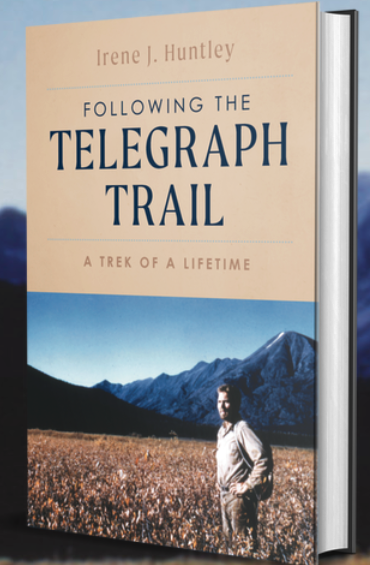Val's Book Reviews

Following the Telegraph Trail: A Trek of a Lifetime
by Irene J. Huntley
Victoria: FriesenPress, 2021
$14.99 / 9781039110441

Irene J. Huntley has written a worthy little book — Following the Telegraph Trail — which documents the adventurous trek taken by her father, Don Huntley, and his friend, Gunnar Nillson, in 1956, as they hiked the famous Telegraph Trail.
Don Huntley had previously worked in the northern part of British Columbia and the Yukon and it was while there that he met Gunnar and had become fascinated by the history of the building of the Telegraph Line between 1900 and 1901. It was an incredible story of the stringing of a single telegraph wire from pole to pole “through the wilderness, to connect the communities of the north to the outside world.”
Don was deeply inspired by these brave men who had also extended the Line from Hazelton north through Atlin to Whitehorse and on to Dawson City, enabling gold miners to link to their families in the south. “The line was the primary source of communication for 35 years,” Irene Huntley writes. “Men employed by the Yukon Telegraph Service lived and worked along the line through the valleys and mountain passes, in order to keep the line repaired and functional. The line stayed in use until 1936.”


Don Huntley was keen to follow in the footsteps of those men along the now long abandoned Trail and his enthusiasm excited Gunnar. Huntley spent considerable time researching the history of this incredible feat and he now wanted to test himself in the wilderness. His wife and family had moved back south to Quadra Island, off Campbell River, and fortunately Don was blessed with a wife who supported his dream even though she knew that the 400-mile trek would be hazardous and a test of her husband’s skills. On August 8th 1956, after a dinner with friends in Whitehorse the night before, the two men set off on their adventure, taking a southerly direction from the Yukon into British Columbia.
Despite studying maps and trying to follow the Trail with sightings of the line to steer them, there were a few mishaps along the way (Editor’s note: see Irene Huntley’s website for a detailed map of the trek). The first part of the Trail was relatively easygoing and they were able to enjoy the beauty of the wilderness and its varied terrain. There was some open country versus dense bush, numerous river and creek crossings, mountain passes and the stress of constantly keeping an eye out for bears, but the joys of the beautiful scenery were mixed with the challenges they encountered including losing their way on one occasion.

I liked the way the author managed to draw out the character of the two very different men — Don the optimistic leader and Gunnar the somewhat pessimistic complainer — but I felt the dialogue she imagined happened between them was somewhat contrived and a little stilted. It was far better when she quoted extracts from Don Huntley’s diary, which were his actual words along the trek.
My only other criticism is that I feel the pictures might have been better served with captions beneath them. Thankfully they are carefully placed in the text where those events happened.


I enjoyed the meticulous description provided by the author about the food they ate and the way they prepared it over open fires. From their supplies, which included things like egg powder, powdered potatoes, pancake mix, dehydrated vegetable mix, sugar and numerous tea bags, they were able to cook up the most delicious-sounding meals along the way. They were able to cook and eat heartily with the addition of any fish they caught or game they were able to shoot.
The second part of their trek was far harder and more dangerous, especially after they lost one of their packs in the Bell-Irving River. That part of the story became very exciting — especially the incredible end result of that mishap which I won’t divulge in this review.


In one of Don’s diary entries at the end of August, he writes:
It took precious hours to build a raft. We crossed the river about 3 pm, just as the rain started again. For about an hour, in the rain, we searched for the Trail on the other side. When we finally found the Trail, it was blocked for miles by flooded beaver ponds, so we had to cross the marshy areas on the beaver dams in the pouring rain. When it was getting dark, we found a dry spot under a group of large spruce trees in the middle of the marsh and made a shelter. We are trying to get the fire hot enough to dry things out. We only travelled about two miles today.
They had travelled far more miles than that every day earlier, so things were definitely getting harder by the time September set in with more inclement weather and cooler temperatures, but the men persevered as best they could.


Irene Huntley and her sisters grew up hearing all these incredible stories from their father when he returned to them, and Irene knew that he had always wanted to write a book about the adventure. Towards the end of his life, however, Don sadly suffered from dementia, but his memory remained good for a time. When he came to live with Irene for six months, she projected the slides she had put together on to a screen for him to identify. Although he could not recall the exact time sequence of his great trek, he vividly recalled names, places, and people during those seven weeks in the wilderness. She vowed that one day she would write the book about his adventure for a wider audience.
She has definitely achieved her father’s dream in this worthwhile short book.
Link to Original Review
“The Ormsby Review, named for pioneering historian and UBC professor Margaret Ormsby, is a remarkable and comprehensive online review of more British Columbia books than you ever imagined existing — the west coast publishing market is lively. It covers fiction, poetry, politics, memoir and much else, as well as a lot of local and west coast history.” – Christopher Moore, September 14, 2020.
Editor and Publisher: Richard Mackie
Mission Statement: The British Columbia Review, formerly The Ormsby Review, is a lively and inclusive Vancouver-based online journal devoted to the literature, arts, culture, and society of British Columbia. Our mandate is to review books by BC-based writers wherever they choose to publish them. We review books from the member publishers of the ABPBC (Association of Book Publishers of BC), but we also review books that are privately printed, self-published, or published by BC writers at publishing houses elsewhere in Canada or abroad. When possible, we also find BC reviewers. Our accessible and authoritative reviews and essays, written by experts in their fields, are packaged as illustrated magazine articles.
The British Columbia Review works with writers, publishers, and literary professionals across Canada to promote books published by BC writers or about British Columbia in all its diversity. We include books by all authors, regardless of race, age, ability, sexual orientation, gender or gender identity, ethnicity, religion, political belief, marital or family status, and/or status as Indigenous, Métis, or Inuit.
The editorial offices of The British Columbia Review are located near Commercial Drive in East Vancouver, in the traditional, unceded, and sometimes overlapping territories of the Musqueam, Squamish, and Tsleil-Wauuth peoples. Indigenous British Columbia, the land on which we live and create, extends over a large area comprising three culture areas, eight language families, and 32 distinct languages. We endeavour to review all books by and about Indigenous BC. Those reviews can be accessed directly here.
